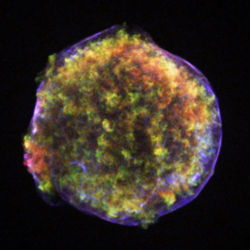Supernovae

A supernova is a violently exploding star. Supernovae can produce as much energy as an entire galaxy for a short period of time and historically have been visible in the daytime. However, they are rather rare in that astronomers estimate that only one or two occur each century in the Milky Way galaxy.
Astronomers recognize two main types of Supernovae. Type I supernovae involve a white dwarf that is part of a binary system. A white dwarf is an earth-size ball of C and O nuclei that is the end state of low mass stars. The gravity of a white dwarf is opposed by electron pressure and there is an upper mass limit of 1.44 MSun known as Chandrasekhar’s Limit. If material flows rapidly from the binary companion star onto the white dwarf, its mass may exceed 1.44 MSun which causes a supernova. The white dwarf is destroyed in a sudden burst of fusion and no remnant is left behind.
Type II supernovae involve very massive stars at the ends of their lives. These stars fuse progressively more massive nuclei in their cores – C, O, Mg, Ne, Si – and finally a core of iron is formed. Since Fe56 is the most stable nuclei it is not possible to get any more energy from nuclear fusion and the death of the star is imminent. The core of Fe is crushed to incredibly high temperatures and pressures by the weight of the overlying materials – until it basically disintegrates – and the all of the overlying layers “bounce” off of the core region. This type of supernova is less energetic than the Type I and typically a massive object such as a neutron star or black hole is formed.

Because supernovae are such energetic events, astronomers can observe them at great distances. In the figure to the left, the supernova is clearly bright enough to be distinguished from its host galaxy.
However, they are brief events often lasting only days and astronomers must work diligently to detect them before they reach their peak brightness and begin to fade. They are only useful as distance indicators if it is possible to calibrate them – to relate their observed brightness profile to absolute magnitudes. Type I supernovae are very uniform and easy to calibrate since astronomers can calculate the amount of energy produced when 1.44 MSun of C and O nuclei fuse. They are much more useful to astronomers as distance indicators than Type II Supernovae.